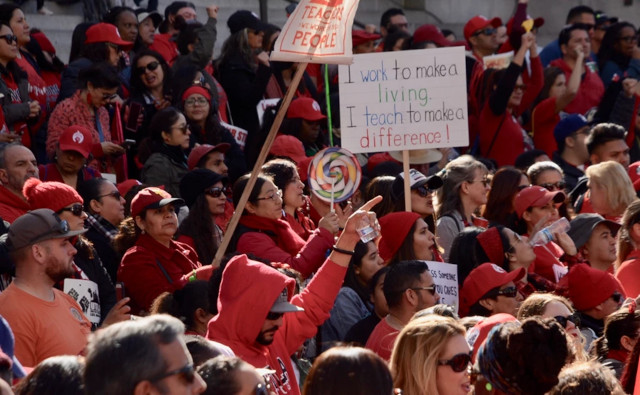Los Angeles, CA…The United Teachers of Los Angeles, California’s largest teachers union, raised eyebrows last summer when it released a report detailing its demanded conditions for a safe reopening of schools. This document went far beyond requesting social distancing plans and personal protective equipment to an agenda that included passing Medicare for All at the federal level, raising state taxes, defunding the police, and imposing a moratorium on charter schools.

Now, in addition to pushing for vaccine access for educators and low community case rates as reopening requirements, the Los Angeles teachers union is requesting that teachers with young children be provided taxpayer-subsidized child care or else continue to be allowed to work from home. On Tuesday, this request was granted, allowing for $500 monthly stipends to teachers and other employees as they return to the classroom. It’s a model that more teachers unions across the country are expected to push.
Closed for in-person learning since last spring, Los Angeles Public Schools are set to reopen on April 12th for half-day sessions for preschoolers and elementary students, followed by middle school and high school students at the end of the month. Frustration over teacher unions blocking school reopenings has escalated in recent weeks, with school districts in some areas filing lawsuits against the unions and governors declaring spring school reopening dates despite union resistance.
This latest move by the Los Angeles teachers union has sparked backlash from parents and others who resent that teachers are asking for taxpayer-funded child care to return to work while many frontline workers have been dutifully doing their jobs in person for over a year, despite exposure to the coronavirus.
“Unions asking for child care accommodations have found themselves playing defense,” reports Politico, “as critics are quick to point out that essential workers like healthcare and grocery store employees who never stopped working in-person are also parents of children who were shut out of schools longer than families in most other states, without the guarantee of child care.”
These recent union demands come on the heels of the new COVID-19 relief bill, passed by Congress last month, that allocates $123 billion to K-12 public schools on top of the $67 billion they received in previous COVID spending bills. With only about 40 percent of US school districts currently open for full-time, in-person learning, an injection of federal funding may seem like it could accelerate school reopenings. Yet, researchers have found that neither lack of funding nor COVID-19 community spread is correlated with schools remaining closed. Instead, teacher union influence is the main indicator of whether or not a school district reopens for in-person learning.
Earlier this week, the Washington Post reported that many school districts are not expecting schools to reopen normally this fall, with remote learning still widespread and masking and social distancing requirements remaining in place.
Writing in The Wall Street Journal last month about their new findings, Corey DeAngelis and Christos Makridis state that “public school funding is either uncorrelated or even negatively correlated with in-person instruction. Some models suggest that schools that went fully remote were better off financially than their in-person counterparts in the same state.” The pair also explains that “union influence, rather than scientific concerns about the spread of the virus, is the primary driver behind reopening decisions.”
Moreover, researchers at Georgetown University discovered that many remote-only school districts were financially flush, including Los Angeles that reported a more than $500 million funding surplus this academic year.
Money clearly isn’t the problem, and yet even with tens of billions of dollars in new federal spending directed at public schools, questions remain regarding when districts will fully reopen for in-person learning and what fall schooling will look like.
Earlier this week, the Washington Post reported that many school districts are not expecting schools to reopen normally this fall, with remote learning still widespread and masking and social distancing requirements remaining in place. Some districts are considering staggered school and bus schedules, and the cafeteria and certain extracurricular activities may continue to be off-limits. The Centers for Disease Control and Prevention (CDC) recently reduced their school social distancing recommendations from six feet to three feet, a change the Post indicates “could set the stage for more disputes this summer and fall between school districts and teachers unions over whether to reopen full time — with students closer together — or part-time, which allows for more distancing.”
The latest demand by the Los Angeles teachers union to supply teachers with taxpayer-funded child care subsidies is part of an ongoing effort by teachers unions to influence public policy, often through hefty donations to the Democratic Party that supports expanding taxpayer-funded universal pre-K and subsidized child care, and secure their monopoly power over public schools. As the Nobel Prize-winning economist, Milton Friedman once said about teachers unions: “They have an enormously strong personal private interest to keep the situation the way it is now where they exercise an effective monopoly position on the public school system—which isn’t public at all. It’s a government school system owned by the teachers union and that’s what the reality is.”
More parents are discovering the outsized influence of teachers unions over their children’s schools. Frustrated by delayed openings and unsatisfactory remote and hybrid learning plans, millions of parents have exited the public school system for private schools and homeschooling this academic year. Support is growing for school choice policies that allow education dollars to follow students instead of schools, and more than two dozen states now have active school choice legislation under consideration. Education entrepreneurs continue to build new learning models that expand education options for families.
As more parents take the reins of their children’s education and seek alternatives to their assigned district school, teachers unions’ “monopoly position on the public school system” may be permanently weakened.



